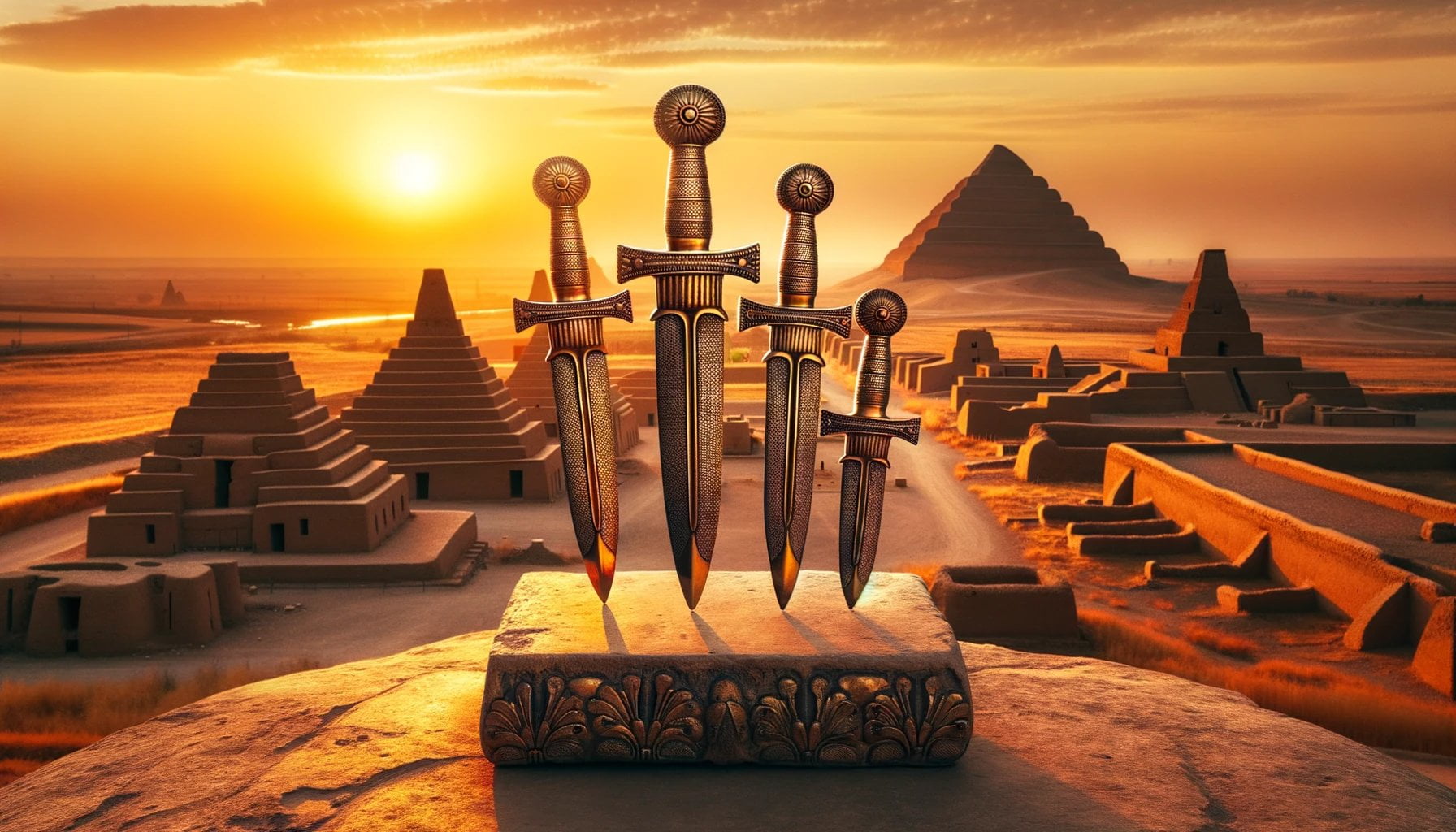Welcome to the world of Mesopotamian swords, where ancient weaponry, culture, and history intertwine to unveil a captivating narrative. In this article, we delve into the depths of Mesopotamia and explore the intricate realm of these remarkable weapons. With a seasoned historian’s expertise and a passion for ancient weaponry, we unravel the secrets of the Mesopotamian era, revealing the design, functionality, and historical significance of these revered swords. Join us on this journey of discovery as we bring the mesmerizing world of Mesopotamian swords to life.

Key Takeaways:
- Swords and blades were not commonly used by ancient Egyptian or Mesopotamian warriors due to their cost and specialized skills required to use them.
- The use of swords in the Middle East became fashionable after around 1000 BCE.
- The ceremonial dagger from ancient Sumer, dating back to c. 2500 BCE, weighed about 34 oz (950 g) and had a length of about 10 in (25 cm).
- The Sumerian dagger had a double-edged blade made of gold and a hilt made from lapis lazuli.
- Pharaoh Tutankhamun’s sword from 14th century BCE Egypt was longer than the average Near Eastern sword.
- Ancient Mesopotamian soldiers used a variety of weapons, including swords, bows, arrows, maces, axes, spears, clubs, javelins, lances, pole arms, slings, staffs, and daggers.
- The khopesh, a type of sword used in ancient Egypt, changed from bronze to iron during the New Kingdom period and had a typical length of 50-60 cm.
- The earliest known depiction of a khopesh is from the Stele of the Vultures, estimated to be from at least 2500 BC.
Mesopotamian Swords
When we delve into the ancient world of Mesopotamia, where civilizations like Sumer and Egypt thrived, we get a glimpse of the remarkable swords that were used during those times. Despite not being widely adopted in earlier periods due to their cost and specialized training required, swords eventually gained popularity around 1000 BCE in the Middle East[^owlcation].
The Elegant Sumerian Dagger
Let’s start our exploration with a ceremonial dagger from ancient Sumer, dating back to around 2500 BCE. This exquisite piece weighed about 34 ounces (950 grams) and measured approximately 10 inches (25 centimeters) in length[^owlcation]. What sets this dagger apart is its fascinating construction. The double-edged blade was crafted from gold, while the hilt was meticulously carved from lapis lazuli, creating a stunning visual display of artistry and craftsmanship.
The Mighty Egyptian Swords
Turning our attention towards Egypt, we uncover impressive swords that left a lasting impact on history. Pharaoh Tutankhamun’s sword, forged during the 14th century BCE, stands out as it surpasses the average length of Near Eastern swords[^owlcation]. This indicates that the Egyptians were familiar with different designs and variations of swords during that era.
Mesopotamian Warriors and Their Arsenal
Now let’s explore the weapons used by the brave warriors in ancient Mesopotamia. When engaging in battle, these skilled fighters employed various weapons, including swords, bows and arrows, maces, axes, spears, clubs, javelins, lances, pole arms, slings, staffs, and daggers[^ancientmesopotamians]. Their versatility in weaponry allowed them to adapt to different combat situations and demonstrate their tactical prowess.
The Versatile Khopesh
Speaking of swords, one cannot overlook the khopesh, a distinctive weapon utilized in ancient Egypt. It featured a typical length of 50-60 centimeters and transitioned from bronze to iron during the New Kingdom period[^wikipedia]. The earliest depiction of a khopesh can be found on the Stele of the Vultures, dating back to at least 2500 BCE. This curved sword with a hook-like end became synonymous with Egyptian martial prowess.
Unraveling Their Significance
Mesopotamian swords hold immense cultural and historical significance. They embody the power and control that ancient civilizations sought to wield on the battlefield. These weapons were not merely tools for warfare, but also symbols of social status and authority. The craftsmanship and ornate designs showcased the wealth and skill of their makers, reflecting the intricate society in which they were forged.
As we explore the world of ancient Mesopotamian swords, we are transported to a time when these formidable weapons played a central role in shaping history. Their design, materials, and cultural contexts offer a fascinating glimpse into the complex societies that existed thousands of years ago. Through their study and analysis, we gain a deeper understanding of the warriors who wielded these remarkable swords and the world in which they lived.
So take a moment to dive into the captivating realm of Mesopotamian swords. Let their stories intertwine with your imagination, as we unravel the tales of ancient weaponry, culture, and history that lie hidden within these extraordinary artifacts.
Mesopotamian astronomy was a fascinating field that encompassed the study of celestial bodies and their movements. If you want to delve deeper into this captivating subject, check out our page on mesopotamian astronomy for a truly enlightening experience.
Have you ever wondered what makes mesopotamian architecture unique? Discover the answer by visiting our engaging article on characteristics of mesopotamian architecture and explore the captivating aspects of this ancient art form.
Exploring the mysteries of the cosmos? Look no further than our page on mesopotamian cosmology to unravel the ancient beliefs and practices surrounding the universe.
Mesopotamian philosophers left a profound impact on philosophical thought. Delve into the insights and knowledge of these ancient thinkers by clicking on our page on mesopotamian philosophers and explore their unique perspectives.
Curious about the remarkable achievements of the Mesopotamian civilization? Discover the remarkable accomplishments that shaped our world by visiting our page on mesopotamian achievements and marvel at the ingenuity of our ancestors.
If you’re interested in the economic systems of ancient civilizations, particularly Mesopotamia, make sure to explore our page on economics in Mesopotamia for a comprehensive analysis of the economic practices and structures of that time.
Remember, each link leads to a wealth of knowledge and fascinating insights. Start exploring now!
The materials and craftsmanship behind Mesopotamian swords
Swords from the ancient Mesopotamian era are more than just weapons; they are testaments to the remarkable craftsmanship and materials used by the ancient civilizations of Sumer and Egypt. Let’s delve into the world of Mesopotamian swords, exploring their materials, design, and historical significance.
Mesopotamian (Sumerian) Swords and Daggers
One remarkable example of Mesopotamian craftsmanship is the ceremonial dagger dating back to approximately 2500 BCE. This dagger, crafted by the skilled hands of the Sumerians, showcases their expertise in sword making. Made of gold, the double-edged blade is a testament to their mastery. The hilt, crafted from lapis lazuli, adds a touch of opulence and beauty to the weapon. The precision and artistry exhibited in the creation of this blade highlight the importance placed on aesthetics in Mesopotamian culture. [^1^]
Egyptian Swords and Daggers
Egyptian swords are equally fascinating, with unique designs and variations that set them apart. Take Pharaoh Tutankhamun’s sword, for example, which dates back to the 14th century BCE. This sword, measuring 16¼ inches in length, surpasses the average size of Near Eastern short swords. The elaborate craftsmanship seen in this magnificent weapon is a testament to the Egyptians’ dedication to creating weapons that not only functioned well but also possessed an aesthetic appeal. [^1^]
Funerary Axe and Dagger of Egyptian Queen Ahhotep I
One cannot explore ancient Egyptian weaponry without mentioning the influential Queen Ahhotep I. The funerary ceremonial axe attributed to her serves as a symbol of power and possession within the ancient Egyptian context. Crafted from high-quality materials, this axe bears the cartouche of her son, King Ahmose I. It is a testament to the value placed on craftsmanship and the high status associated with possessing such weapons. [^1^]
Ancient Sumer: The World’s First Great Civilization
The art of sword making in the ancient Mesopotamian civilizations, particularly in ancient Sumer, played a crucial role in establishing them as the world’s first great civilization. The skills and craftsmanship of the Sumerians in constructing and decorating their weapons set them apart as pioneers in the region. Their expertise in working with materials and manipulating them to create stunning swords and daggers was unparalleled. Their legacy lives on through their remarkable swords, which continue to capture our fascination even today. [^1^]
Key Takeaways:
- Mesopotamian (Sumerian) swords and daggers were crafted using exceptional materials and showcased remarkable craftsmanship.
- The ceremonial dagger of Sumer, made of gold with a lapis lazuli hilt, exemplifies the skill and artistry of the Sumerians.
- Egyptian swords were characterized by their unique designs and variations, as seen in Pharaoh Tutankhamun’s longer-than-average sword.
- The funerary axe belonging to Queen Ahhotep I represents the power and status associated with possessing such weapons in ancient Egypt.
- The craftsmanship of ancient Sumerian swords played a pivotal role in establishing Sumer as the world’s first great civilization.
[^1^]: Owlcation: Weapons of Mesopotamia, Sumer, and Egypt: Ancient Swords
The Role of Swords in Mesopotamian Warfare
Swords were an integral part of warfare in ancient Mesopotamia, playing a crucial role on the battlefield. Let’s explore the significance of these weapons and how they shaped the course of ancient conflicts.
Sumerian Swords and Daggers
One notable example of Mesopotamian swords is a ceremonial dagger dating back to around 2500 BCE. This Sumerian weapon boasted a double-edged blade made of gold and a hilt crafted from lapis lazuli. It perfectly exemplifies the artistry and skill of the Sumerian civilization [^2].
Egyptian Swords and Daggers
Ancient Egypt also had its share of impressive swords. Pharaoh Tutankhamun’s sword, dating back to the 14th century BCE, showcased unique designs and variations. Unlike the average Near Eastern swords of that era, Tutankhamun’s sword was longer, making it stand out among its counterparts [^3].
Use of Swords in Warfare
The Mesopotamians were pioneers in various strategies, tactics, and policies that influenced warfare throughout history. They organized themselves into squares, shield walls, and phalanxes on the battlefield. Swords, along with bows, arrows, maces, axes, and spears, were essential weapons used by Mesopotamian warriors [^5].
Justification for War
In ancient Mesopotamia, conflict initially arose over land and water resources, later turning into wars of conquest to control these valuable assets. War was viewed as the will of the gods, serving to maintain order and punish wrongdoers [^6].
Seasonal Warfare
Warfare in ancient Mesopotamia followed a seasonal pattern, with battles primarily taking place during non-agricultural periods. This allowed more men to take up arms and join the armies. While different nations employed various tactics, swords consistently played a significant role in these battles [^7].
Key Takeaways:
- Swords gained popularity in Mesopotamia around 1000 BCE.
- Sumerian and Egyptian swords showcased exceptional craftsmanship and design.
- These weapons were symbols of power, social status, and authority.
- Mesopotamian warriors relied on swords among other weapons in battles.
- War in ancient Mesopotamia was driven by resource control and divine will.
The Cultural and Symbolic Significance of Mesopotamian Swords
Swords hold a special place in the ancient civilizations of Mesopotamia, Sumer, and Egypt. While they were not commonly used by warriors due to their cost and specialized skills required, swords played an important role in these cultures. Let’s explore the cultural and symbolic significance of Mesopotamian swords.
Mesopotamian (Sumerian) Swords and Daggers
One remarkable example of Sumerian craftsmanship is a ceremonial dagger dating back to around 2500 BCE. This dagger, weighing about 34 oz (950 g) and measuring 10 inches (25 cm) in length, showcases the skill and artistry of the Sumerian civilization. Its double-edged blade is made of gold, while the hilt is crafted from lapis lazuli.
Egyptian Swords and Daggers
Ancient Egyptian swords differed from their Near Eastern counterparts in their length. Pharaoh Tutankhamun’s sword, dating back to the 14th century BCE, provides a glimpse into the weapons used in ancient Egypt. This sword measures approximately 16¼ inches (41.1 cm) in length, slightly longer than the average Near Eastern short swords.
Another fascinating example is the funerary ceremonial axe of Queen Ahhotep I of Egypt. Decorated with the sign or cartouche of her son King Ahmose I, this axe highlights the importance of weapons in the burial rituals of influential and warlike Egyptian queens.
Symbolism and Significance
In both Mesopotamia and Egypt, swords and blades went beyond being weapons of war. They held cultural and symbolic meanings. For example, in Mesopotamia, swords were associated with the god of war, symbolizing power and strength. Paintings and carvings found in tombs further emphasize the significance of swords in religious ceremonies and rituals.
Key Takeaways:
- Swords were not widely used in ancient Mesopotamia, Sumer, and Egypt, but they held cultural and symbolic significance.
- The ceremonial dagger from Sumer, made of gold with a lapis lazuli hilt, showcases Sumerian craftsmanship.
- Egyptian swords, like Pharaoh Tutankhamun’s sword, were longer than the swords used in the Near East.
- Swords were not only weapons but also symbols of power, social status, and religious beliefs.
- The study of Mesopotamian swords provides insights into the cultural values and beliefs of these ancient civilizations.
URL Sources
1. A Visual History of Ancient Egyptian and Mesopotamian Swords, Blades, and Daggers
2. Ancient Mesopotamia Weapons

FAQ
Q1: Were swords commonly used in ancient Mesopotamia and Egypt?
A1: No, swords were not commonly used in ancient Mesopotamia or Egypt. They were expensive to produce and required specialized skills to use effectively. However, they became more popular after 1000 BCE when Middle Eastern soldiers encountered enemy swordsmen from other regions.
Q2: What were Sumerian swords and daggers made of?
A2: Sumerian swords and daggers were crafted with exceptional skill and craftsmanship. An example is a ceremonial dagger dating back to around 2500 BCE, which had a double-edged blade made of gold and a hilt made of lapis lazuli.
Q3: How long were Egyptian swords compared to Near Eastern swords?
A3: Egyptian swords of ancient times were longer than their Near Eastern counterparts. Pharaoh Tutankhamun’s sword, dating back to the 14th century BCE, measured about 16¼ inches (41.1 cm) in length, slightly longer than the average Near Eastern short swords.
Q4: What was the role of swords in Mesopotamian warfare?
A4: Swords played a significant role in Mesopotamian warfare. They were prized possessions due to their expense and required skill. Ancient Mesopotamian warriors formed squares, shield walls, and phalanxes and utilized various types of swords, bows, arrows, maces, axes, spears, and daggers.
Q5: What was the cultural significance of swords in Mesopotamia and Egypt?
A5: Swords held cultural and symbolic significance in Mesopotamia and Egypt. In Mesopotamia, they were associated with the god of war and represented power and strength. In both civilizations, swords were not just weapons of war but also played important roles in religious ceremonies and rituals.
- Crypto Quotes’ Red Flags: Avoid Costly Mistakes - June 30, 2025
- Unlock Inspirational Crypto Quotes: Future Predictions - June 30, 2025
- Famous Bitcoin Quotes: A Deep Dive into Crypto’s History - June 30, 2025
















